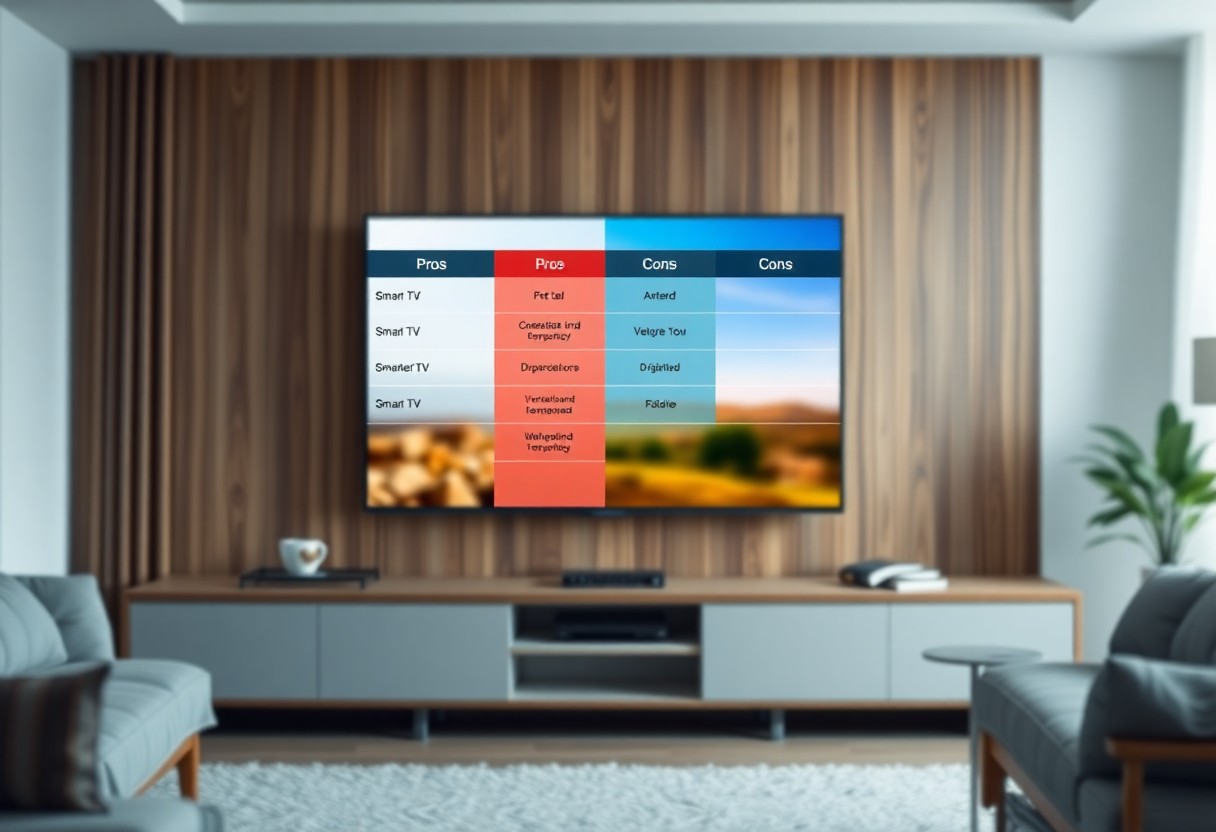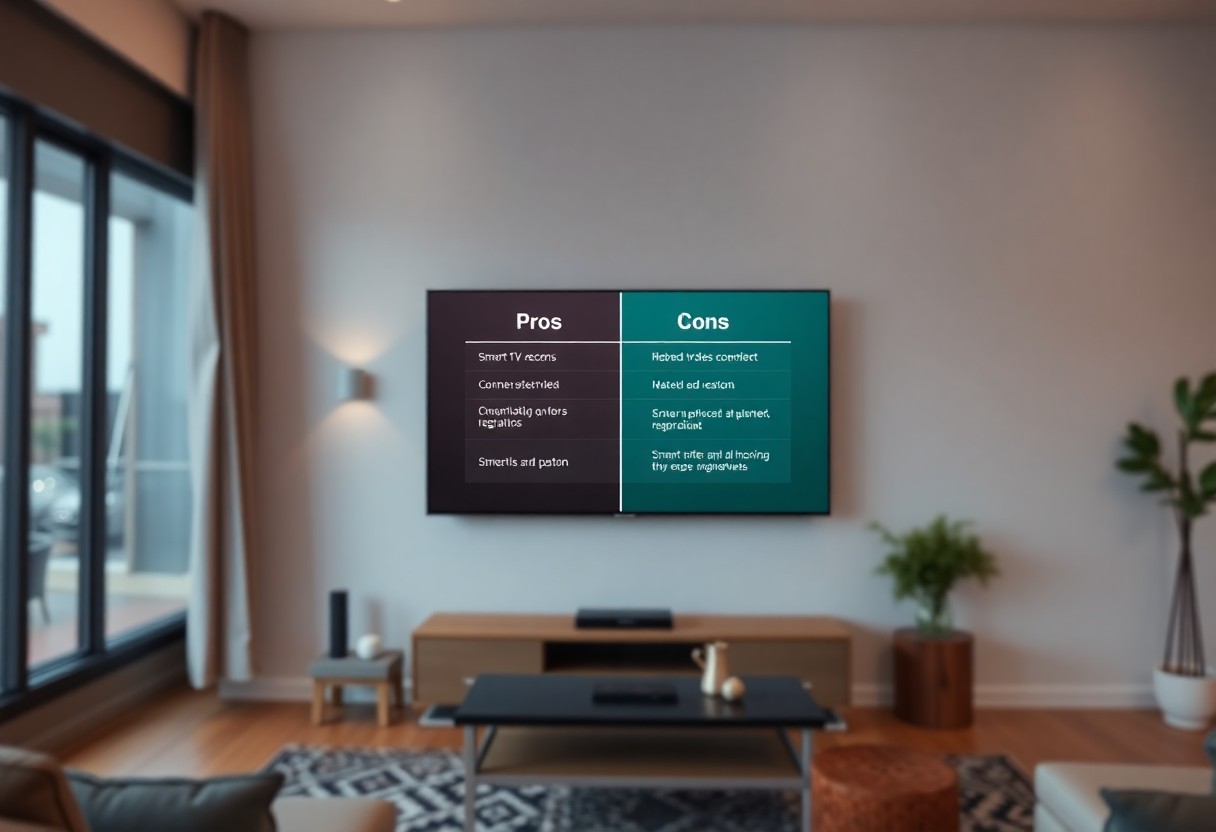Many viewers today find themselves torn between the advanced features of smart TVs and the simplicity of traditional TVs. As you navigate your viewing options, understanding the advantages and disadvantages of each type can help you make informed decisions that best suit your lifestyle and preferences. From streaming capabilities to user interfaces, this comparison will outline key factors you should consider to enhance your viewing experience. Dive in to discover what aligns with your viewing habits more effectively.

Contents
Understanding Smart TVs
For the modern viewer, smart TVs represent a significant evolution in television technology. These devices integrate internet connectivity, allowing you to stream content directly from various services, access apps, and enhance your overall viewing experience. They combine traditional television functions with the capabilities of computers, giving you unprecedented access to entertainment, social media, and more, all from the comfort of your living room.
Features of Smart TVs
Across the range of available smart TVs, you’ll find numerous features designed to enrich your viewing experience. These may include voice control, built-in streaming services, touchscreen interfaces, and the ability to connect with smart home devices. You can enjoy a personalized experience by downloading apps tailored to your interests and preferences.
Internet Connectivity and Apps
Below the surface of smart TVs lies their impressive internet connectivity and app ecosystem, which form the backbone of their functionality. With Wi-Fi or Ethernet capabilities, you can easily connect your smart TV to the internet and access a world of digital content.
Features like built-in browsers and access to various app stores enable you to download your favorite streaming applications, weather widgets, and social media platforms. This connectivity allows for seamless software updates, enhancing your TV’s performance over time. Furthermore, many smart TVs support screen mirroring from your mobile devices, ensuring you can easily share photos, videos, and other content right on your TV screen.

Traditional TVs: A Closer Look
Any discussion about television must include traditional TVs, which have long been the foundation of home entertainment. These models have stood the test of time, providing viewers with dependable performance and a straightforward design. While they may lack advanced features, they still hold a special place for those who appreciate simplicity and reliability in their viewing experience.
Features of Traditional TVs
Against the backdrop of rapidly evolving technology, traditional TVs remain equipped with basic features that cater to everyday viewing needs. They predominantly include standard resolutions, access to cable or satellite channels, and necessary inputs for DVD players or gaming consoles. While they may lack the bells and whistles of newer models, they deliver consistent picture quality for linear broadcasts, making them a sensible choice for many households.
Lack of Smart Features
After the rise of smart TVs, the absence of smart features in traditional models has become a notable downside. Traditional TVs typically lack built-in apps or internet connectivity, limiting your access to popular streaming platforms and online content. This means that for viewers leaning towards binge-watching their favorite shows or movies, a traditional TV can feel quite restrictive.
The traditional viewing experience can feel limited, as you are often dependent on external devices like streaming boxes or DVD players to access modern content. Without smart capabilities, you miss out on features like voice control, user profiles, and seamless integration with other smart devices in your home, which can enhance your overall viewing experience. As the entertainment landscape continues to shift towards digital media, it’s necessary to consider how the absence of smart features might affect your viewing habits and access to the content you love.
Pros of Smart TVs
You can enjoy a wealth of features that enhance your viewing experience, making smart TVs increasingly popular among modern viewers. With built-in internet connectivity, smart TVs allow you to access a wide array of streaming platforms, download apps, and even integrate with your smart home devices, placing endless entertainment options at your fingertips.
Streaming Services and Content Access
Against traditional TVs, smart TVs offer seamless access to a vast array of streaming services, such as Netflix, Hulu, and Amazon Prime Video. This means you can easily find and watch your favorite shows or movies without needing multiple devices or subscriptions, creating a more streamlined viewing experience.
User-Friendly Interfaces
Above all, smart TVs come with intuitive, user-friendly interfaces that make navigation a breeze. This ease of use is necessary in ensuring that you spend less time grappling with complicated controls and more time enjoying your favorite content.
Services integrated into the smart TV interface often feature personalized recommendations based on your viewing habits, making it even easier for you to discover new entertainment. The straightforward design allows quick access to apps, settings, and content libraries, providing a smooth and enjoyable user experience, whether you are streaming, browsing, or downloading.
Cons of Smart TVs
Not all features of Smart TVs are advantageous. They often come with drawbacks that can affect your viewing experience. From concerns about privacy to the need for constant internet connectivity, these issues can detract from the convenience that Smart TVs provide.
Privacy Concerns
By using a Smart TV, you may inadvertently expose your personal data. Many of these devices gather information about your viewing habits and preferences, raising questions about how this data is used. Knowing that your TV could be collecting information without your explicit consent might make you pause before fully embracing a Smart TV.
Dependence on Internet Connectivity
Connectivity is crucial for Smart TVs, as many of their features are reliant on an internet connection. Without stable internet access, your viewing choices become significantly limited. You may encounter buffering issues, reduced streaming quality, or even an inability to access certain apps, which can lead to frustration when you just want to enjoy your favorite content.
With Smart TVs that depend on internet connectivity, your viewing experience may suffer during outages or slow connections. If you live in an area with less reliable internet service, you might find yourself frequently dealing with interruptions. This dependence can make it challenging to unwind and enjoy your smart features, leading you to reconsider whether a Smart TV aligns with your lifestyle and viewing preferences.
Pros of Traditional TVs
Many viewers appreciate traditional TVs for their straightforward functionality and reliability. Without the added technology of smart TVs, these devices often require less maintenance and are easier to navigate for all ages. You can enjoy watching shows without the distractions of apps or frequent software updates. For a deeper understanding of the differences, check out Smart TV vs. Regular TV: Is it Worth the Upgrade?.
Simplicity and Ease of Use
Any user can appreciate the simplicity of traditional TVs, which are designed for a straightforward viewing experience. You won’t need to worry about navigating through multiple apps or interfaces; just plug it in, turn it on, and enjoy your favorite channels right away.
Cost-Effectiveness
Around the cost of a smart TV, you can often find a high-quality traditional TV at a more affordable price. This makes it an attractive option for those looking to save money while still enjoying quality entertainment. The initial investment is usually lower, eliminating concerns about future software updates or subscription fees.
Plus, traditional TVs can save you money in the long run. With no need for internet connectivity or additional subscription services associated with smart TVs, you can enjoy a great viewing experience without ongoing costs. This makes traditional TVs an appealing choice if you’re looking to minimize expenses while still enjoying your favorite programs.
Cons of Traditional TVs
All traditional TVs come with limitations that may affect your viewing experience. They typically lack many modern functionalities that smart TVs offer, which can leave you feeling restricted in how you consume content. As technology advances, traditional models struggle to keep pace with the growing demand for interactivity and internet connectivity that modern viewers increasingly expect.
Limited Features
Beside lacking internet connectivity, traditional TVs often miss out on features like built-in apps, voice control, and streaming options. Without smart functions, you find yourself relying on external devices, which can complicate your setup and require additional remotes to manage various content sources. This disconnect can detract from the seamless experience many expect in the digital age.
Declining Relevance in the Streaming Era
Beside the technical limitations, traditional TVs are slowly becoming less relevant in a world dominated by streaming services. With platforms like Netflix and Hulu leading the charge, viewers are shifting towards on-demand content that traditional broadcasting cannot easily provide. As more people favor media that offers flexibility and variety, your traditional TV may increasingly feel outdated.
Features like live streaming and on-demand shows have transformed how you consume entertainment, making traditional TVs less practical for modern viewing habits. The rise of smart TVs allows you to access a vast array of content at your fingertips, putting traditional models at a disadvantage. If you primarily enjoy streaming services, relying on an outdated setup might limit your ability to enjoy the content you love effectively.
Summing up
Drawing together the information on Smart TVs and traditional TVs, you can see both have their unique advantages and disadvantages. Smart TVs offer you the convenience of streaming and connectivity, making it easier to access a variety of content. However, traditional TVs provide a straightforward viewing experience without the need for internet or complex setups. Your choice will depend on your personal viewing habits, budget, and how much you value additional features. Weighing these factors will help you make the best decision for your home entertainment needs.

Leave a Reply